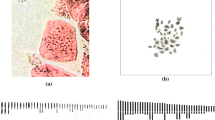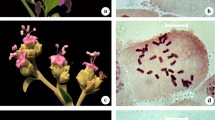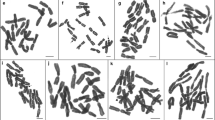Abstract—The present study aimed to study the Karyomorphological analysis of seven species of Passiflora (P. edulis, P. foetida, P. subpeltata, P. quadraqularis, P. ligularis, P. leschenaultii, and P. tripartitia). The species are exhibited the diploid status with difference in chromosome number, i.e., P. edulis f. flavicarpa (2n = 18), P. foetida var. foetida (2n = 20), P. subpeltata (2n = 18), P. quadrangularis (2n = 18), P. ligularis (2n = 18), P. leschenaultii (2n = 18) and P. tripartita (2n = 18) with perceptible difference in the karyotypic features, total chromosome length (TCL), and the total arm Percentage (TF%). Low TF% (38.05%) observed in varieties of P. foetida point to the evolved nature of the species. Idiogram were constructed based on relative length of chromosomes.

Similar content being viewed by others
REFERENCES
Cervi, A.C., Species of Passiflora L. (Passifloraceae) published and described during the last 55 years (1950–2005) in South America and in the main Brazilian Publications, Estud. Biol., 2005, vol. 27, no. 61, pp. 19–24.
Meletti, L., Soares-Scott, M.D., and Beracci, L.C., Phenotypic characterization in three selections of purple passion fruit (Passiflora edulis Sims.), Rev. Bra. frutic., 2005, vol. 27, no. 2, pp. 268–272. http://www.scielo.br/ scielo.php?pid=S0100-9452005000200020&script= sci_arttext.
Shekhawat, M.S., Kannan, N., Manokari, M., and Ravindran, CP., In vitro regeneration of shoots and ex vitro rooting of an important medicinal plant Passiflora foetida L. through nodal segment culture, Genet. Eng. Biotechn. N., 2015, vol. 12, no. 2, pp. 209–214. https://www.sciencedirect.com/science/article/pii/ S1687157X15000335.
Vandetplank, J., Passion Flowers and Passion Fruit, Cassel Publishers limited, 2000. https://www.cabdirect.org/cabdirect/abstract/19920311355.
Rushing, F. Tough Plants for Southern Gardens, Cool Spring Press, 2003. http://agris.fao.org/agris-search/ search.do?recordID=US201300091552.
Soares, T.L., de Jesus, O.N., de Souza, E.H., and de Oliveira, E.J., Reproductive biology and pollen pistil interactions in Passiflora species with ornamental potential, Sci. Horticult., 2015, vol. 197, no. 0, pp. 339–349. https://www.sciencedirect.com/science/article/ pii/S0304423815302090.
De Melo, C.A.F., Souza, M.M., Abreu, P.P., and Viana, A.J.C., Karyomorphology and GC-rich heterochromatin pattern in Passiflora (Passifloraceae) wild species from Decaloba and Passiflora subgenera, Flora—Morphology, Distribution, Funct. Ecol. Plants, 2014, vol. 209, no. 11, pp. 620–31. https://www.sciencedirect.com/science/article/pii/S0367253014001169.
Hansen, A.K., Gilbert, L.E. Simpson, B.B., Downie, S.R., Cervi, A.C., and Jansen, R.K., Phylogenetic relationships and chromosome number evolution in Passiflora,Syst. Bot., 2006, vol. 31, no. 1, pp. 138–150. https://www.ingentaconnect.com/content/aspt/sb/ 2006/00000031/00000001/art00013.
Stebbins, G.L., Chromosomal evolution in higher plants, in Chromosomal Evolution in Higher Plants, 1950. https://www.cabdirect.org/cabdirect/abstract/ 19711606614.
Silvia M., Cuco Maria Lucia C. Vieira, Mateus Mondin, and Margarida L.R., Aguiar-Perecin Comparative karyotype analysis of three Passiflora L. species and cytogenetic characterization of somatic hybrids. Caryologia, 2005, vol. 58, no. 3, pp. 220–228. https://www.tandfonline.com/doi/abs/10.1080/00087114.2005.10589454.
Das A.B., Mallick R. Variation in karyotype and nuclear DNA content in different varieties of Foeniculum vulgare Mill., Cytologia, 1989, vol. 54, no. 1, pp. 129–134. https://www.jstage.jst.go.jp/article/cytologia1929/54/1/ 54_1_129/_article/-char/ja/.
Shan F., Yan G., and Plummer J.A., Karyotype evolution in the genus Boronia (Rutaceae). Bot. J. Linnean Soc., 2003, vol. 142, no.3, pp. 309–320. https://www. cabdirect.org/cabdirect/abstract/20057005072.
Killip E.P. The American species of Passifloraceae. The American species of Passifloraceae., 1938. https://www. cabdirect.org/cabdirect/abstract/20057005072.
Ohdachi S., Dokuchaev N.E., Hasegawa M., and Masuda R. Intraspecific phylogeny and geographical variation of six species of north-eastern Asiatic Sorex shrews based on the mitochondrial cytochrome b sequences. Mol. Ecol., 2001, vol. 10, no. 9, pp. 2199–2213. https://doi.org/10.1046/j.1365-294X.2001.01359.x
Bhadra S., Bandyopadhyay M. New chromosome number counts and karyotype analyses in three important genera of Zingiberaceae. Nucleus, 2016, vol. 59, no. 1, pp. 35–40. https://link.springer.com/article/10.1007/ s13237-016-0162-7.
Zeng J., Wang D., Wu Y., Guo X., Zhang Y., and Lu X., Karyotype analysis of Gazania rigens varieties, Horticult. Plant J., 2016, vol. 2, no. 5, pp. 279–283. https://www.sciencedirect.com/science/article/pii/S2468014116301601.
Huziwara Y. Karyotype analysis in some genera of Compositae. VIII. Further studies on the chromosomes of Aster, Am. J. Bot., 1962, vol. 49, no. 2, pp. 116–119. https://doi.org/10.1002/j.1537-2197.1962.tb14916.x
De Melo, F., Cervi, A.C., and Guerra, M., Karyology and cytotaxonomy of the genus Passiflora L. (Passifloraceae), Plant System. Evol., 2001, vol. 226, no. 1, pp. 69–84. https://link.springer.com/article/10.1007/s006060170074.
Battaglia, E., Chromosome morphology and terminology (with 12 figures), Caryologia, 1955, vol. 8, no. 1, pp. 179–187. https://www.tandfonline.com/doi/pdf/ 10.1080/00087114.1955.10797556.
Iwatsubo, Y. and Naruhashi, N., Karyomorphological and cytogenetical studies of Rubus parvifolius, R. coreanus and R. × hiraseanus (Rosaceae), Cytologia, 1991, vol. 56, no. 1, pp. 151–156. https://doi.org/10.1508/cytologia.56.151
Naruhashi, N., Iwatsubo, Y., and Pen,g, C.I., Chromosome numbers in Rubus (Rosaceae) of Taiwan, Bot. Bull. Acad. Sin., 2002, p. 43.
Mandakova, T., Schranz, M.E., Sharbel, T.F., de Jon,g, H., and Lysak, M.A., Karyotype evolution in apomictic Boechera and the origin of the aberrant chromosomes, Plant J., 2015, vol. 82, no. 5, pp. 785–793. https://doi.org/10.1111/tpj.12849
Sassone, A.B., López, A., Hojsgaard, D.H., and Giussani, L.M., A novel indicator of karyotype evolution in the tribe Leucocoryneae (Allioideae, Amaryllidaceae), J. Plant Res., 2018, vol. 131, no. 2, pp. 211–223. https://doi.org/10.1007/s10265-017-0987-4
De Storme, N. and Mason, A., Plant speciation through chromosome instability and ploidy change: cellular mechanisms, molecular factors and evolutionary relevance, Cur. Plant Biol., 2014, vol. 1, pp. 10–33. https://doi.org/10.1016/j.cpb.2014.09.002
Storey, W.B., Chromosome numbers of some species of Passiflora occurring in Hawaii, 1950. https://scholarspace.manoa.hawaii.edu/bitstream/10125/8988/vol4n1-37-42.pdf.
De Souza, M.M., Pereira, T.N.S., and Vieira, M.L.C., Cytogenetic studies in some species of Passiflora L. (Passifloraceae): a review emphasizing Brazilian species, Braz. Arch. Biol. Technol., 2008, vol. 51, no. 2, pp. 247–258. https://doi.org/10.1590/S1516-89132008000200003
de Souza, M.M., Pereira, T.N.S., da Cruz Silva, L., da Silva Reis, D.S., and Sudré, C.P., Karyotype of six Passiflora species collected in the state of Rio de Janeiro, Cytologia, 2003, vol. 68, no. 2, pp. 165–171. https://doi.org/10.1508/cytologia.68.165
Silvia, M.C., Vieira, M.L.C., Mondin, M., and Aguiar-Perecin, M.L., Comparative karyotype analysis of three Passiflora L. species and cytogenetic characterization of somatic hybrids, Caryologia, 2005, vol. 58, no. 3, p. 2208. https://doi.org/10.1080/00087114.2005.10589454
Ahirwar, R.A.M.E.S.H. and Verma, R.C., Karyotypic studies in some members of Liliaceae, J. Cytol. Genet., 2014, vol. 15, pp. 61–74. http://socg.in/jrnls/2014/part2.pdf.
Viana, A.J.C. and Souza, M.M., Comparative cytogenetics between the species Passiflora edulis and Passiflora cacaoensis,Plant Biol., 2012, vol. 14, no. 5, pp. 820–827. https://doi.org/10.1111/j.1438-8677.2011.00557.x
Gg de Belo, G.O., Souza, M.M., de Souza, V.O., and de Melo, C.A.F., Reproductive and cytogenetic characterization in Passiflora sublanceolata,Biologia, 2015, vol. 70, no. 6, pp. 733–743. https://doi.org/10.1515/biolog-2015-0089
Yanaka, N., Kotera, J., Ohtsuka, A., Akatsuka, H., Imai, Y., Michibata, H., and Omori, K., Expression, structure and chromosomal localization of the human c GMP binding c GMP specific phosphodiesterase PDE5A gene, Eur. J. Biochem., 1998, vol. 255, no. 2, pp. 391–399. https://doi.org/10.1046/j.1432-1327.1998.2550391.x
Malik, A. and Srivastava, A.K., The fine structure of safflower (Carthamus tinctorius L.) chromosomes as revealed by pachytene analysis, Cytologia, 2009, vol. 74, no. 3, pp. 289–293. https://doi.org/10.1508/cytologia.74.289
El-Esawi, M.A. and Sammour, R., Karyological and phylogenetic studies in the genus Lactuca L. (Asteraceae), Cytologia, 2014, vol. 79, no. 2, pp. 269–275. https://doi.org/10.1508/cytologia.79.269
Mandakova, T. and Lysak, M.A., Chromosomal phylogeny and karyotype evolution in x = 7 crucifer species (Brassicaceae), Plant Cell, 2008, vol. 20, no. 10, pp. 2559–2570. https://doi.org/10.1105/tpc.108.062166
Gill, B.S., Friebe, B., and Endo, T.R., Standard karyotype and nomenclature system for description of chromosome bands and structural aberrations in wheat (Triticum aestivum), Genome, 1991, vol. 34, no. 5, pp. 830–839. https://doi.org/10.1139/g91-128
ACKNOWLEDGMENTS
The authors are grateful to the Head, Department of Botany, University of Kerala for Providing the felicities.
Author information
Authors and Affiliations
Corresponding author
About this article
Cite this article
Beena, V.L., S. Suhara Beevy Intervarietal Karyomorphological Studies on Two Species of Passiflora L. (Passifloraceae). Cytol. Genet. 54, 465–471 (2020). https://doi.org/10.3103/S0095452720050126
Received:
Revised:
Accepted:
Published:
Issue Date:
DOI: https://doi.org/10.3103/S0095452720050126




